Blockchain History Timeline - Updated Weekly
From technological advances to regulatory changes, it covers everything you need to know about this revolutionary technology.
This is a detailed timeline of every remarkable moment in the history and evolution of blockchain technology.
It includes major breakthroughs, technological advances, key adoption milestones, and regulatory changes.
Note that this is a living document and will be updated regularly as new events unfold.
Here are some of the key highlights:
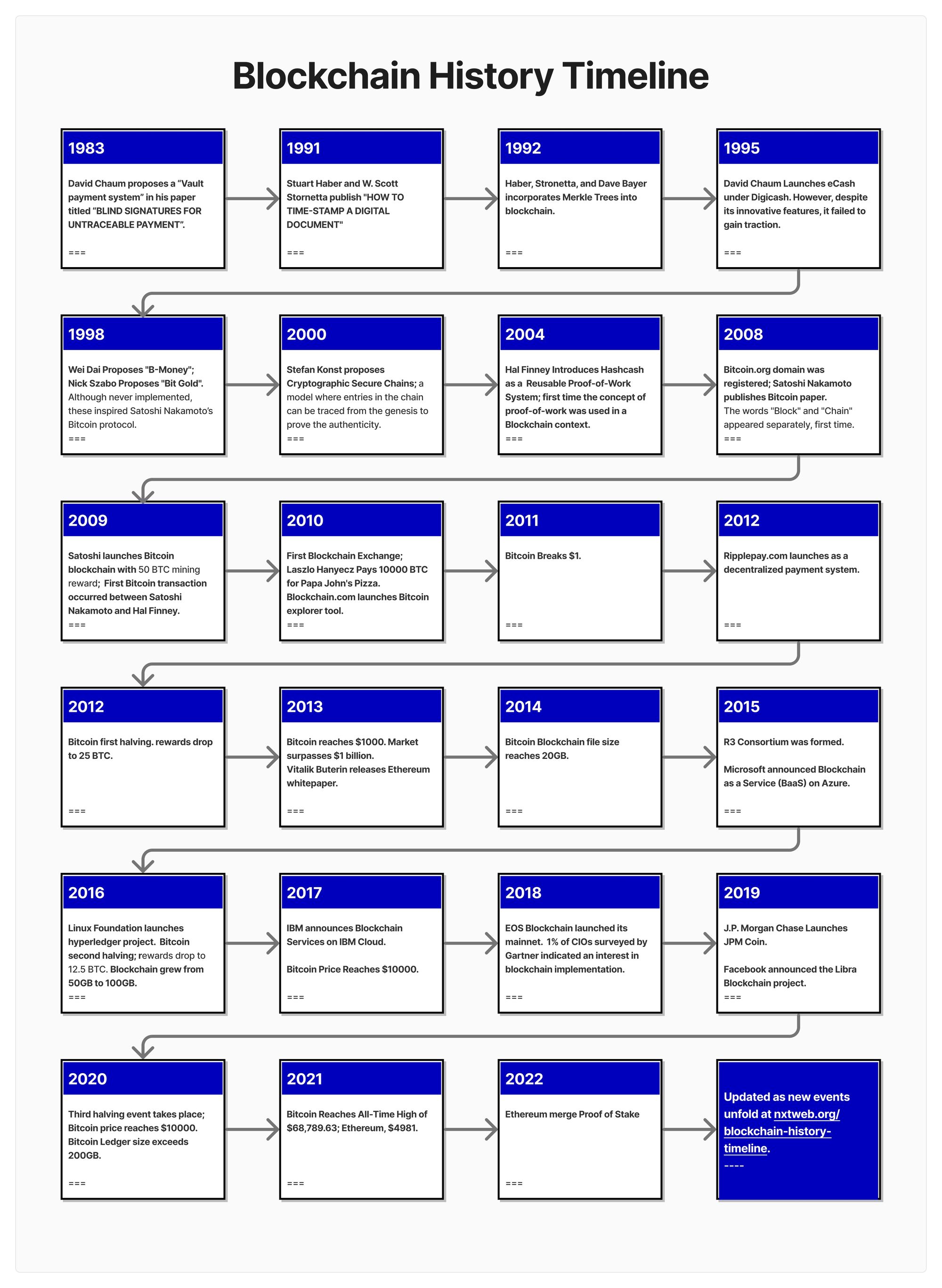
1983: David Chaum Proposed a Vault Payment System
The genesis starts with David Chaum, a computer scientist.
In 1983, Chaum published a paper titled “BLIND SIGNATURES FOR UNTRACEABLE PAYMENT”, which featured what he called a 'Vault".
The system would be based on cryptographic principles and would allow users to make anonymous transactions.
The idea of the vault was to create a more efficient and secure way to make payment details:
- Private: the sender and receiver would be the only ones who know about the transaction.
- Provable: the transaction would be verifiable and tamper-proof.
- Punishable: the proposed system would allow users to stop the use of payment media reported stolen.
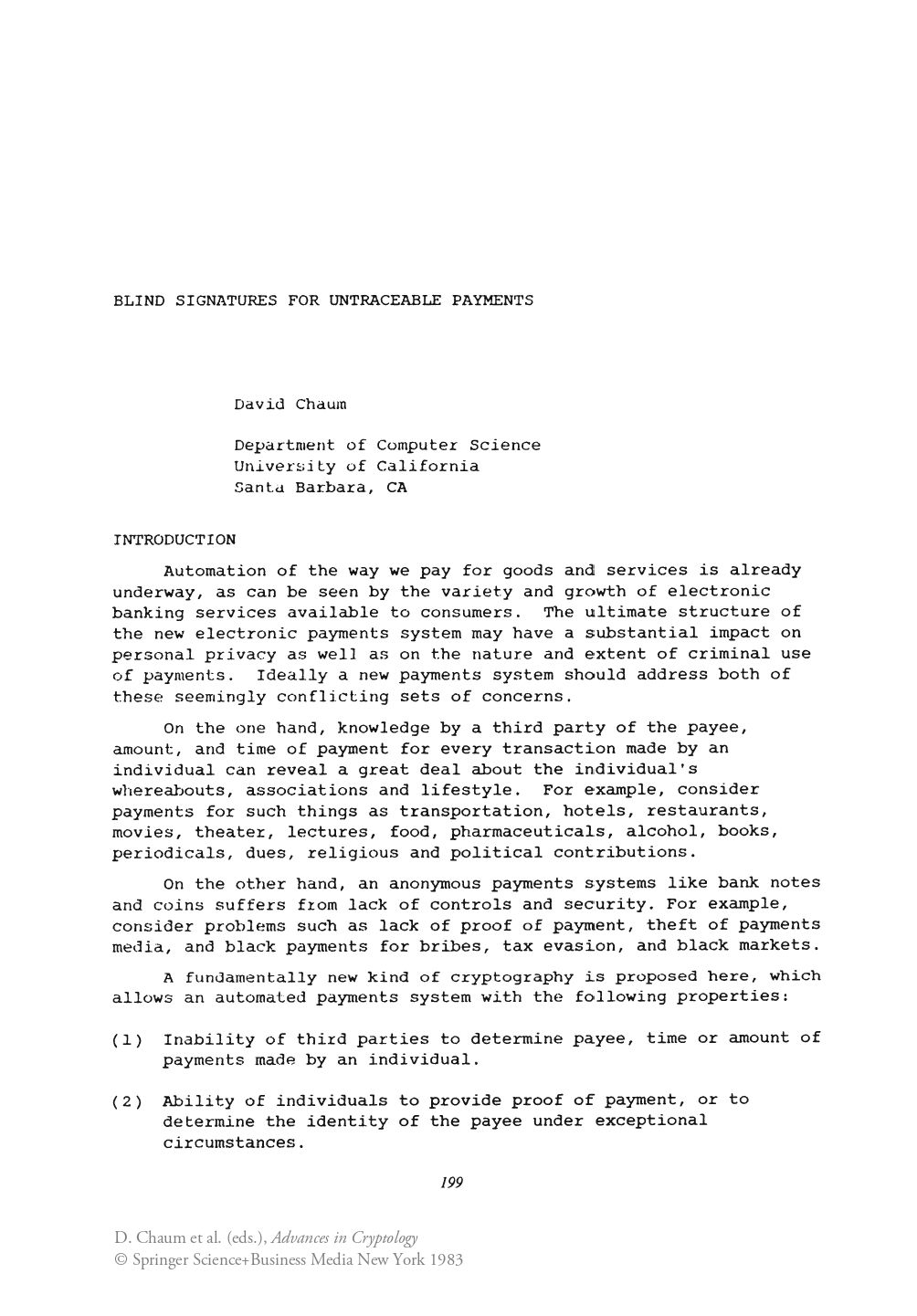
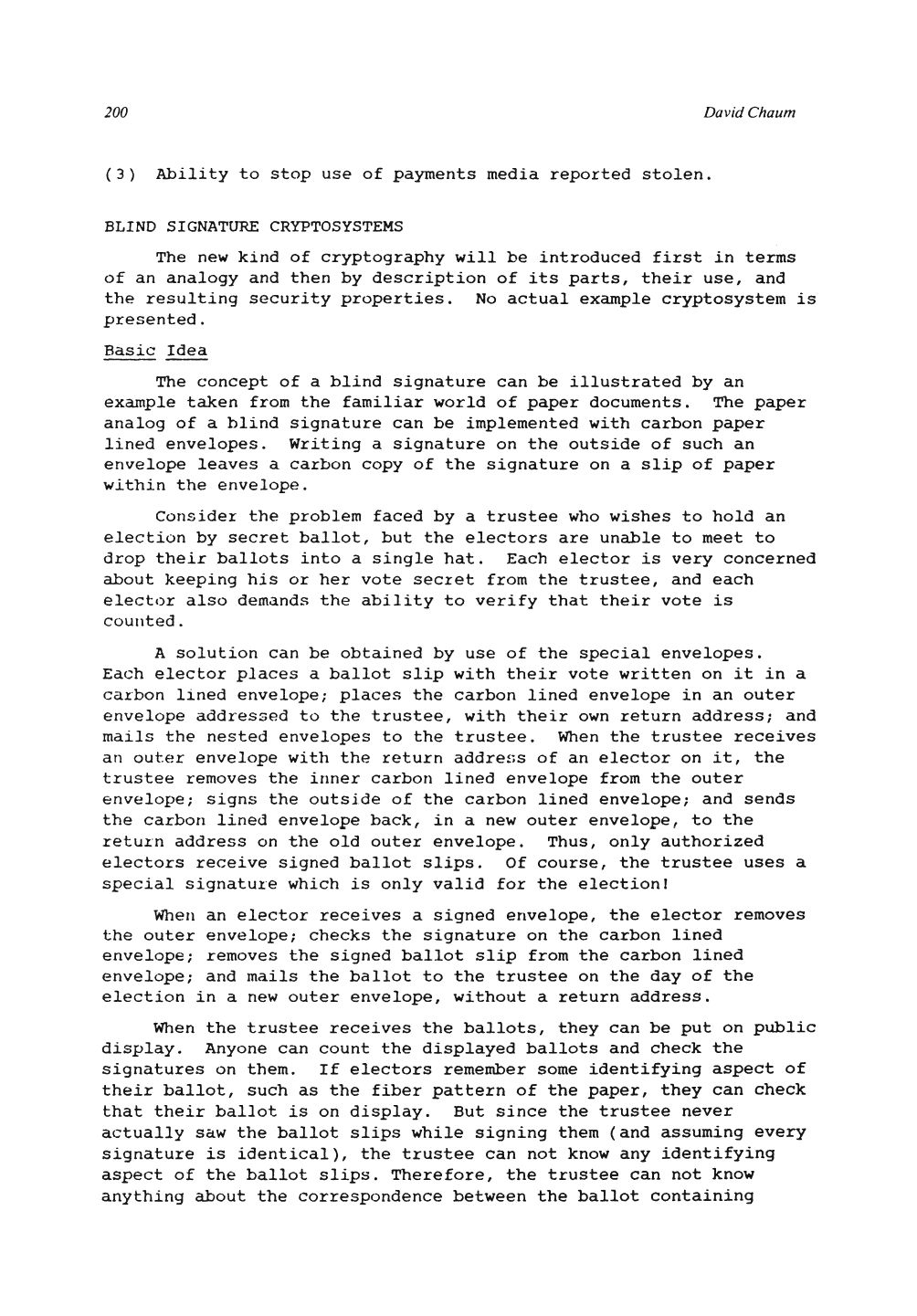
The paper was well received by the cryptography community and is still considered one of the most influential works in the field.
While the vault never came to fruition, Chaum's work laid the foundation for future digital payment systems, including blockchain.
1991: Stuart Haber and W. Scott Stornetta Publish "How to Time-Stamp a Digital Document"
The next significant step in the history of blockchain came in 1991 when Stuart Haber and W. Scott Stornetta published a paper titled "How to Time-Stamp a Digital Document".
In the paper, the authors proposed a system for time-stamping digital documents so that they could not be backdated or tampered with.
The system would use a chain of hash-based signatures, with each new document being signed by the previous one.
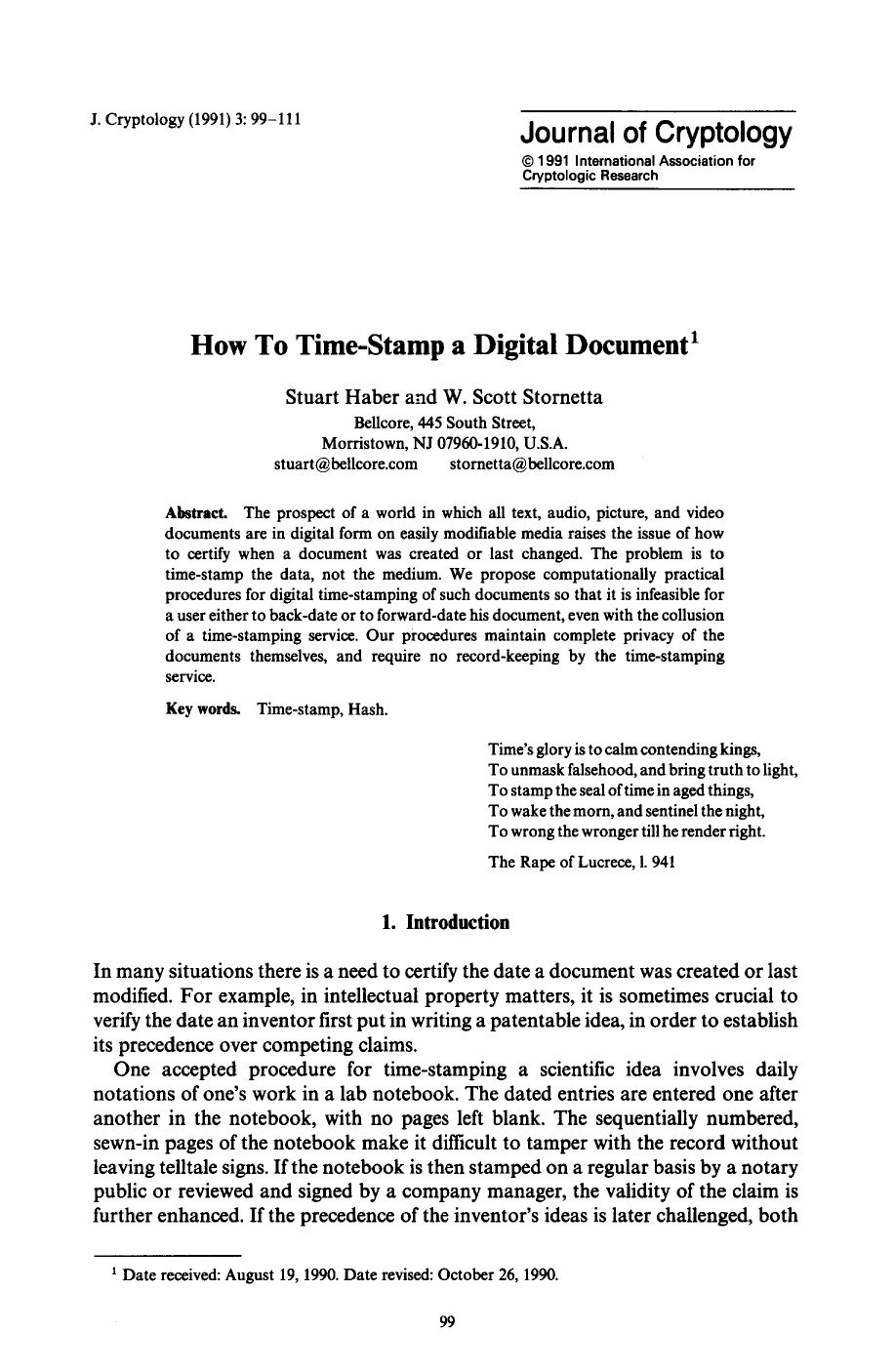
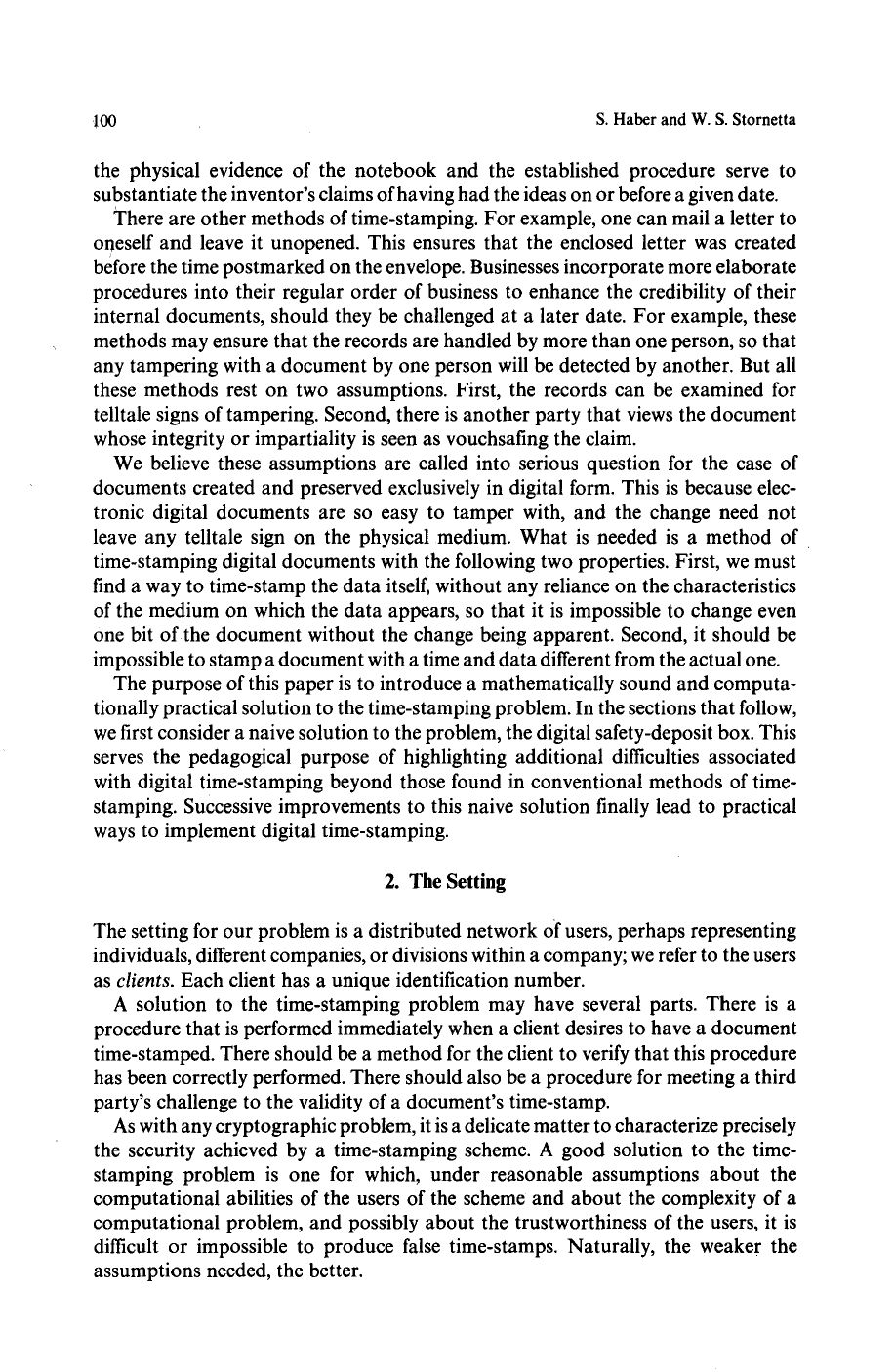
This was the first time that the idea of a blockchain was proposed and it laid the foundation for Bitcoin's Blockchain.
1992: Haber, Stronetta, and Dave Bayer Incorporates Merkle Trees Into Blockchain
In 1992, Haber, Stornetta, and Dave Bayer incorporated Merkle trees into the blockchain design.
Merkle trees are a data structure that allows for efficient and secure verification of large data sets.
This was a significant improvement to the original Blockchain design as it allowed for much more efficient verification of transactions.
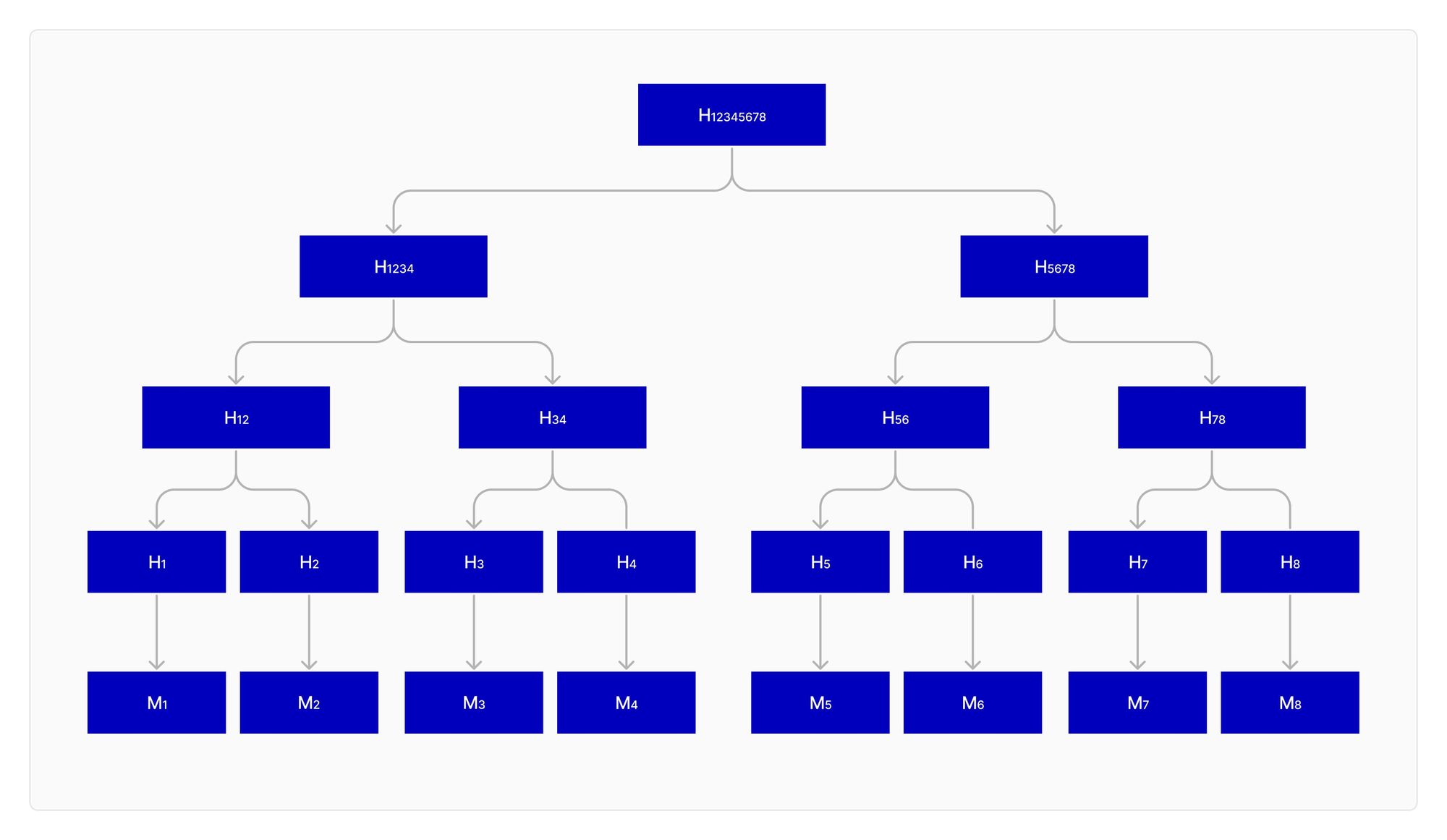
1995: David Chaum Launches eCash under Digicash
In 1995, David Chaum launched eCash, a digital cash system based on his 1982 paper
eCash was one of the first practical applications of the vault system and allowed users to make anonymous transactions.
However, despite its innovative features, eCash failed to gain traction.
Credit cards and other traditional payment methods proved to be more convenient for users and eCash was unable to compete.
They secured a $10 million investment from David Marquardt.
Yet, in the United States, only one bank — the Mark Twain bank in Saint Louis, MO — implemented ecash, testing it as a micropayment system.
The project eventually failed in 1998.
1998: Wei Dai Proposes "B-Money"
In 1998, Wei Dai proposed "B-money", an anonymous, distributed electronic cash system.
B-money was similar to eCash in that it allowed for anonymous transactions.
However, unlike eCash, B-money did not rely on a central authority and was instead based on a peer-to-peer network.
The project never officially launched, but it inspired the next project, "Bit Gold."
1998: Nick Szabo Proposes "Bit Gold"
In 1998, Nick Szabo proposed "Bit Gold", a decentralized digital currency.
Bit Gold was similar to B-money in that it was based on a peer-to-peer network.
Bit Gold combines cryptography and mining to accomplish decentralization, including time-stamped blocks that are stored in a title registry and are generated using proof-of-work (PoW) strings.
Although never implemented, it was the precursor to Satoshi Nakamoto's Bitcoin Protocol.
2000: Stefan Konst proposes Cryptographic Secure Chains
In 2000, Stefan Konst proposed Cryptographic Secure Chains (CSCs), a Blockchain system for secure communication.
CSCs presented a model where entries in the chain can be traced from the genesis to prove the authenticity.
The same model we see in Bitcoin and other cryptocurrencies today.
2004: Hal Finney Introduces Hashcash as a Reusable Proof-of-Work System
In 2004, Hal Finney introduced Hashcash as a reusable proof-of-work system.
Hashcash was designed to be used as an anti-spam measure and it required users to complete a proof-of-work computation in order to send an email.
This was the first time that the concept of proof-of-work was used in a Blockchain context.
2008, August: Bitcoin.org domain was registered
On August 18, 2008, the domain name "bitcoin.org" was registered.
This marked the beginning of Bitcoin and Blockchain history.
2008, October: Satoshi Nakamoto Publishes Bitcoin Paper
On October 31, 2008, Satoshi Nakamoto published the Bitcoin white paper titled "Bitcoin: A Peer-to-Peer Electronic Cash System."
In this paper, Nakamoto proposed a decentralized electronic cash system that would allow for online payments to be sent directly from one party to another without the need for a third party.
The Words "Block" and "Chain" appeared separately in the document, but this was the first time these two concepts were combined in the context of a Blockchain.
The paper also introduced the concept of a Blockchain and how it could be used to achieve decentralization.
2009: Satoshi Launches Bitcoin Blockchain; Implements Genesis Block with 50 BTC per Block Mining Reward
On January 03, 2009, Satoshi Nakamoto mined the first block of the Bitcoin Blockchain, also known as the "genesis block."
This block had a mining reward of 50 BTC, which is the reward that miners receive for verifying transactions and adding them to the Blockchain.
2009: First Bitcoin Transaction Occurs Between Satoshi and Hal Finney
On January 12, 2009, the first Bitcoin transaction occurred between Satoshi Nakamoto and Hal Finney.
Finney was an early adopter of Bitcoin and helped Nakamoto with testing the Bitcoin software.
The identity of Satoshi Nakamoto remains a mystery.
Hal Finney died on August 28, 2014.
2010: Bitcoin Market Established; First Blockchain Exchange; Laszlo Hanyecz Pays 10000 BTC for Papa John's Pizza
Bitcoin Market was the first Bitcoin exchange.
On May 22, 2010, the first Blockchain transaction occurred when Laszlo Hanyecz paid 10000 BTC for Papa John's Pizza.
This is widely considered to be the first real-world Bitcoin transaction.
Hanyecz's pizza purchase helped to establish a market for Bitcoin and showed that Blockchain technology could be used for more than just sending money.
He sold the 10000 BTC for large Papa John's pizzas at $15 a piece. At Bitcoin's all-time high, that was $687,896,300.
2010, November: Blockchain.com Launches Bitcoin Explorer tool
On November 09, 2010, Blockchain.com launched the Bitcoin Explorer tool.
This was a Blockchain explorer that allowed users to view all Blockchain transactions in real time.
It was one of the first Blockchain explorers and remains one of the most popular today.
2011: Bitcoin Breaks $1
On February 09, 2011, Bitcoin prices breached the $USD barrier for the first time.
This was a major milestone in Bitcoin's history and helped to solidify its position as a viable currency.
2012: Ripplepay.com Launched as a Decentralized Payment System
On September 26, 2012, ripplepay.com was launched as a decentralized payment system.
Ripple is a Blockchain platform that allows for the instant and direct transfer of money between two parties.
Ripple is built on a distributed ledger system, and each transaction is verified by a network of computers (known as "nodes") spread across the globe.
Till today, Ripple remains one of the most popular Blockchain platforms.
2012, November: Bitcoin First Halving. Rewards Drop to 25 BTC
On November 28, 2012, the Bitcoin Blockchain underwent its first "halving."
This event happens every 210,000 blocks (roughly every four years) and results in the mining reward being cut in half.
2013: Bitcoin Reaches $1000; Cyprus Bailout
On November 27, 2013, Bitcoin breaks $100, then $1,000 — then falls.
This was a major milestone and helped to legitimize Bitcoin as a viable currency.
The same year, Cyprus became the first country to bail out a bank with Blockchain technology.
The Cyprus bailout showed that Blockchain could be used for more than just payments, but also for other financial applications.
2013: Vitalik Buterin releases Ethereum whitepaper; Bitcoin marketplace surpasses $1 billion
On November 23, 2013, Vitalik Buterin released the Ethereum whitepaper.
Buterin was a co-founder of Bitcoin Magazine and is now the founder of Ethereum.
The Ethereum Blockchain is a decentralized platform that runs smart contracts: applications that run exactly as programmed without any possibility of fraud or third-party interference.
It applies Bitcoin's Blockchain technology to a wider range of applications beyond just payments.
The same year, Bitcoin surpassed $1 billion in total value.
Ethereum is now the second largest Blockchain platform after Bitcoin.
2014: Bitcoin Blockchain File Size Reaches 20GB
On March 11, 2014, the Blockchain file size reached 20GB.
This was a major milestone, as it showed that Bitcoin was continuing to grow and scale.
2015 December: R3 Consortium Was Formed
On December 01, 2015, the R Consortium was formed.
The consortium is a group of banks and financial institutions that are working together to develop Blockchain technology for use in the banking industry.
Some of the members include Goldman Sachs, JPMorgan Chase, Barclays, Credit Suisse, and HSBC.
2015: Microsoft Announces Blockchain as a Service on Azure
On November 12, 2015, Microsoft announced Blockchain as a Service (BaaS) on Azure.
This was a major move by Microsoft, as it showed that they were serious about Blockchain technology and wanted to make it easier for developers to build Blockchain applications.
Azure is a cloud computing platform that allows developers to build, test, and deploy applications.
2016, Feb: Linux Foundation Launches Hyperledger Project
The Linux Foundation launched the Hyperledger project in December 2015.
The goal of the project is to create a robust, enterprise-grade, open-source distributed ledger framework and platform for developing applications or solutions with a modular architecture.
The project is being jointly developed by IBM and Samsung among other tech giants and it has received support from financial institutions such as J.P Morgan, Deutsche Börse and Hitachi.
2016: Bitcoin second halving. Rewards drop to 12.5 BTC
On July 09, 2016, the Bitcoin Blockchain underwent its second "halving."
2016: Bitcoin blockchain grew from 50GB to 100GB
On November 06, 2016, the Blockchain size grew from 50GB to 100GB.
2017 August: IBM Announces Blockchain Services on IBM Cloud
In December of 2017, IBM announced its plans to launch blockchain services on the IBM cloud.
This was a big move for the company, and it put them in a good position to become a leader in the industry.
BM's blockchain services are built on the Hyperledger Fabric platform by the Linux Foundation.
It is designed for enterprise use cases. With IBM's blockchain services, developers will be able to build applications on top of the Hyperledger Fabric platform.
These applications will be able to take advantage of the security and immutability of the blockchain.
In addition, they will be able to leverage the scalability of the IBM Cloud. Developers will also have access to tools that will make it easy to develop and deploy applications on the IBM Cloud.
2017, November: Bitcoin Price Reaches $10000
On November 28, 2017, the price of Bitcoin reached $10000.
This was a major milestone for Bitcoin, as it showed that it was continuing to grow in popularity and value.
2018: EOS Blockchain Launches Mainnet
On January 31, 2018, the EOS Blockchain launched its mainnet.
EOS is a Blockchain platform that enables developers to build decentralized applications.
The launch of the EOS mainnet was a major milestone, as it showed that the platform was ready for use by developers.
Since its launch, EOS has become one of the most popular Blockchain platforms in the world.
2018: 1% of CIOs surveyed by Gartner indicated an interest in blockchain implementation
In 2018, Gartner released the results of a survey of 3,138 CIOs from 84 countries and various industries.
One percent of those surveyed indicated that they had already invested in blockchain technology, while an additional 9 percent said they would do so within the next 12 months.
However, this number was expected to grow in the coming years, as more and more organizations begin to see the benefits of Blockchain technology.
2019 - 60% of CIOs surveyed by Gartner said they were not planning to invest in Blockchain technology in the next three years.
In 2019, Gartner released the results of a survey of Blockchain adoption.
The survey showed that 60 percent of CIOs were not planning on investing in Blockchain technology in the next three years.
However, this number was expected to change as more organizations begin to see the benefits of Blockchain technology.
2019, February: J.P. Morgan Chase Launches JPM Coin
On February 2019, J.P. Morgan became the first U.S. bank to create and successfully test a digital coin representing a fiat currency.
The JPM Coin is based on blockchain-based technology enabling the instantaneous transfer of payments between institutional clients.
2019, June: Facebook Announces Libra Blockchain Project
On June 18, 2019, Facebook announced the Libra Blockchain project.
The goal of the project is to create a global cryptocurrency that will be used by billions of people around the world.
The project was being developed by a consortium of companies, including Facebook, Visa, Mastercard, PayPal, and Uber.
The project failed after legal battles and regulatory pushback.
2020, March: Third halving event takes place; Bitcoin price reaches $10000
On May 11, 2020, the third Bitcoin halving event took place.
This event reduced the block rewards for miners from 12.50 BTC to 625 BTC.
The halving event caused a lot of excitement in the crypto community, as it was seen as a positive development for Bitcoin.
The price of Bitcoin reached $10000 just a few days after the halving event.
2020: Bitcoin Ledger size had exceeded 200GB.
As of May 2020, the Bitcoin Blockchain ledger size had exceeded 200GB.
This growth is due to the increasing number of transactions taking place on the Blockchain.
It is expected that this trend will continue in the future, as more and more people begin to use Bitcoin.
2021, Nov: Bitcoin Reaches All-Time High of $68,789.63; Ethereum, $4981
On November 20, 2021, Bitcoin reached an all-time high price of $68,789.63.
Ethereum also hit an all-time high price of $4981.70 on the same day.
This was a major milestone for Bitcoin, as it showed that the cryptocurrency was continuing to grow in popularity and value.
2022 May: UST Stable Coin Crashes From $1 to 35 cent
UST an algorithmic stablecoin crashed from $0.99 to $0.35 on May 25, 2022.
This was due to a depeg from the reserve currencies, and investors losing confidence in the project.
UST was created by Terra.
2022 September: Ethereum Merge Proof of Stake
Ethereum successfully merged Proof of Stake with their Blockchain.
Ethereum's original Proof of Work was a major contributor to the high electricity consumption of the Blockchain.
The new Proof of Stake algorithm is much more energy efficient and is expected to reduce the carbon footprint of Ethereum by 99%.
Summary of Bitcoin History Timeline
The early days of blockchain were mostly about research and experimentation.
Some key figures in the space, like David Chaum, proposed theoretical systems that would lay the foundation for later work.
Other pioneers, like Stuart Haber and W. Scott Stornetta, published important papers that would help shape the technology.
In the late 1990s and early 2000s, there was a renewed interest in blockchain-like systems.
Wei Dai proposed "B-money", a system for electronic cash. Nick Szabo proposed "Bit Gold", a system for decentralized digital scarcity.
And Stefan Konstanyk proposed "Cryptographic Secure Chains", which would eventually become the basis for the blockchain platform Ethereum.
The first real-world blockchain application was Bitcoin, which was launched in 2009.
Since then, blockchain technology has continued to evolve and be adopted by more and more people and organizations.
Some notable milestones include the launch of Blockchain.com in 2011, the launch of Ethereum in 2014, and the launch of JP Morgan's JPM Coin in 2019.
Looking to the future, it is clear that blockchain technology is here to stay.
And as it continues to grow and evolve, we can only imagine the impact it will have on the world.
We'll be updating this timeline regularly, so be sure to check back often!